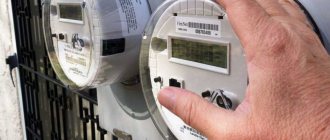There is a house on the site with electricity, but the house is being demolished and we would like to transfer electricity to a new building. Is it possible to do this?
It is possible to do this. Submit a corresponding application to the energy supply organization that serves your locality
Similar questions
lawyer Evgeniy Evgenievich Ovchinnikov:
If you have a lease agreement for a plot of land, for example, then you can.
lawyer Plotnikov Oleg Dmitrievich:
You can connect electricity to an unregistered house, which is built on a plot with another house, for which you need to enter into an agreement with the energy supply company.
lawyer Barannikova Tatyana Nikolaevna:
Regarding the collection of debts from the previous owner of the site, the chairman must file a lawsuit against him. You are not responsible for his debts.
lawyer Kalashnikov Vladimir Valentinovich:
Register in a simplified manner. State registration of citizens' rights in a simplified manner is carried out in accordance with the requirements of Federal Law dated 30.
lawyer Yushkevich Pavel Petrovich:
If your land plot is located within the boundaries of SNT, you have the right to connect
Hello, our family has had a deadlock situation for a very long time, which continues to this day without any development and its change is not expected in the near future. Without going into details, we live on an unregistered plot of land, respectively, in an unregistered house (building), we naturally use utilities in the form of water and electricity and it is also natural that we connected illegally, which we are not particularly happy about because it would be better if we had everything legally, what we have been trying to achieve for a long time, but oh well, this is all lyrics, the essence of the problem is that let’s say the water utility goes down to meet us, he gave us a personal account on which we pay for the service received, and the power engineers say that they do not have such an opportunity and therefore either cut off the wire from the network or throw in acts. The question is the following, since we live in Crimea, maybe our The energy workers are bustling around and according to Russian laws there is still the possibility of a legal connection, at least a tiny one?
Paperwork
To connect a site without buildings to electrical networks, a standard package of documents is required.
It includes:
- the applicant's civil passport;
- a certificate confirming the applicant’s ownership of the land plot;
- plan diagram of the territory of the land plot with the designation of the nearest power line poles;
- plan diagram of the territory of the land plot indicating the location of utilities.
If documents are submitted by a third party, a power of attorney to perform the relevant actions must be attached to the list of main papers. Based on the submitted documents, the network organization will issue technical conditions according to which all further work will be carried out.
What is temporary connection to power supply circuits?
In most situations, individuals and organizations enjoy access to electrical networks in accordance with a signed agreement with the energy supply organization. In this case, documents are drawn up for a long period. For operation, the energy meter is connected and installed. As a result, the consumer receives electricity.
A device must be installed to monitor electricity consumption Source deilo.ru
In some cases, it may be necessary to temporarily join foreign networks. The most common situation of this kind is construction work. When performing them, a variety of equipment is used, which consumes significant amounts of electricity. Such work is carried out where the client needs it, therefore, there is a need to connect to the network available here.
You can learn how to submit an application by watching the video:
Project development
The technical specifications indicate:
- network power, including the maximum load of the energy consuming facility;
- list of electricity meters;
- the presence of a sealed box in cases of external connection.
Technical specifications are issued within thirty days. After receiving them, it is necessary to draw up a project and purchase electrical equipment that corresponds to the document. The most commonly purchased devices are an electric meter, a switch, a machine, cables, wires and lighting fixtures. When developing a project, it is necessary to depict a diagram of external power supply and internal wiring. The design must show the types of wires and electrical devices.
Video description
Agreement and technical conditions for technological connection to electrical networks.
It is important to remember that networks made on a temporary basis cannot be used in the future to supply power to capital construction projects. In such a situation, the connection must be made again in accordance with the established rules.
Payment for performing the procedure is charged once. If the form of ownership or organization of the parties changes, re-registration is not required.
Technological connection is carried out after the contract is signed by the electricity supplier Source ruscable.ru
Electrification stages
After drawing up the project, the installation stage of the electrical supply system begins. Installation must be carried out in full accordance with the approved document, otherwise overvoltage in the network may occur. If all project requirements are met, a work acceptance certificate is drawn up and permission to operate electricity on the site is issued. The next step is to install seals on all elements of the system that supply voltage. After this, another act is signed.
Connecting electricity to a plot of land without buildings is possible in one of two ways:
- by laying wires underground;
- by laying the cable by air.
The second method is considered less expensive because it does not require excavation work. At the same time, this method has its drawbacks: power lines can break due to adverse weather conditions: strong wind, icing, etc.
When connecting wires to a site, experts recommend installing self-supporting insulated wires, which provide protection from damage.
Connecting electricity underground
Connecting electricity to a site without buildings using an underground method requires a significant investment of physical effort and financial resources. The advantage of this method is its reliability and security of the system, which provides protection from negative external factors.
The underground method includes the following work:
- preparing a trench with a depth of about 75 centimeters (below the soil freezing level);
- backfilling the cable with a layer of sand (about 20 centimeters);
- clearing the ditch of debris, removing sharp objects that could damage the wires.
When using this method, a wire without conductive cores is used. The most commonly used two-phase cable is rated at 220 volts. The wire is masked with a corrugated pipe, protecting it from mechanical damage.
Video description
How to apply for technological connection from July 1, 2020.
To do this, you need to complete paperwork and ensure compliance with certain rules. After this, an electrical connection will be made, allowing the necessary work to be carried out.
4 stages of temporary connection Source smolinvest.com
Electricity connection conditions
When connecting electricity to a plot of land without buildings, the following requirements must be met:
- the distance from electrical supports to the border with the site should be more than ten meters;
- the distance from wires to trees and other obstacles should be more than one and a half meters;
- when using the aerial method of conducting electrical networks, the height from the ground must be more than six meters.
The cost of all work will depend on the location of the site, its distance from power grids, and the presence of power line poles.
Another important factor influencing pricing is the voltage power in the electrical network. Connecting the site to existing networks will cost less than building new supports.
You can deal with the preparation of all the necessary documentation yourself or by contacting companies specializing in these types of work.
Compiling an application
This document does not have a strictly established form, but it must contain all the necessary information. When submitting an application from an individual for a connection with a power of no more than 15 kW, the document must display the following:
- Personal data of the applicant, which includes last name, first name and patronymic.
- It is necessary to reflect passport data - series, number, date and place of issue.
- Indicate place of residence.
- It is necessary to list the equipment that needs to be supplied with power, and also indicate the location.
- Timeframes for launching energy-consuming facilities.
- You need to report the maximum power value for each.
Electricity tariffs in small towns
Electricity tariffs in Russia depend on the type of settlement in which the household with sources of energy consumption is located. There is a preferential electricity tariff for residents of rural areas. As a rule, the discount on the preferential tariff is 30%, but it is set at the regional level.
But there is one subtlety here: only residents of areas that have the official status of a rural municipality can use the benefit.
If a garden, dacha association or cottage community is located outside a rural municipality and does not have the status of a village, you will have to pay at city rates.
The same applies to residents of urban-type settlements. Although many settlements are not much different from villages, and the income of most residents is far from urban, they have to pay the city tariff.
Detailed information about benefits is in the article “Electricity Tariffs in Rural Areas.”
Tariffs in the Moscow region
The above also applies to the Moscow region, where the urban population pays more for electricity than the rural population. In addition, regional tariffs are revised every year. From 01/01/21, based on the single-rate tariff for the population, residents of cities (Balashikha, Dolgoprudny, Zhukovsky, Korolev, Kolomna, and so on) must pay 5.73 rubles/kW/h.
At the same time, for the rural population of the region it amounted to only 4.01 rubles.
In addition to the one-rate rate, there are tariffs differentiated by two and three zones per day. Simply put, different rates apply at different times of the day.
And yet, territorial differentiation remains - rural residents pay less.
Details are contained in the material “Electricity Tariffs in the Moscow Region.”
How to properly conduct electricity to a plot of land
Let's talk about the procedure for connecting electricity, that is, about all the necessary steps.
First, you must write a statement that you want to connect electricity to your site. Next, you will be told about all the necessary technical conditions for connecting electricity.
Read here! The socket is sparking - determining the cause of the sparks and how to troubleshoot the problem (photo + instructions)
We fulfill all the conditions that were provided to you. Then the site will be connected to the power grid, and commissioning work will begin.
Afterwards, you will be given several certificates: a certificate that your site is connected to any electrical network, a certificate of delimitation of balance sheet ownership and a document on the responsibility of both parties during operation.
Your site will be connected to the electrical network, which in turn is connected to power receiving devices. The company will also install and seal a specially installed meter for metering the electricity used, otherwise known as an electricity meter.
The last point is that the owner of the land plot enters into an agreement with the organization that supplies electricity.
Electrification under the federal program
Sometimes you can hear mention of the federal program for the electrification of garden partnerships, individual housing construction plots and other land plots. Sources have different interpretations of the content and conditions of this program. They have one thing in common - supposedly preferential connection conditions, under which you can arrange electrification of a plot, cottage, household or other property for only 550 rubles.
However, 550 rubles is the standard cost for connecting individuals using up to 15 kW for domestic purposes, provided that the nearest distribution station or power pole is located within a radius of 300 (500) m from their site. The specified amount applies to all consumers who fall under these conditions.
As for preferential electrification programs, there are no such programs at the federal level. However, they may well exist at the regional level. For example, in the Yaroslavl region, since 2013, the Program for the consolidation and restoration of the power grid complex of gardening partnerships has been in effect.









